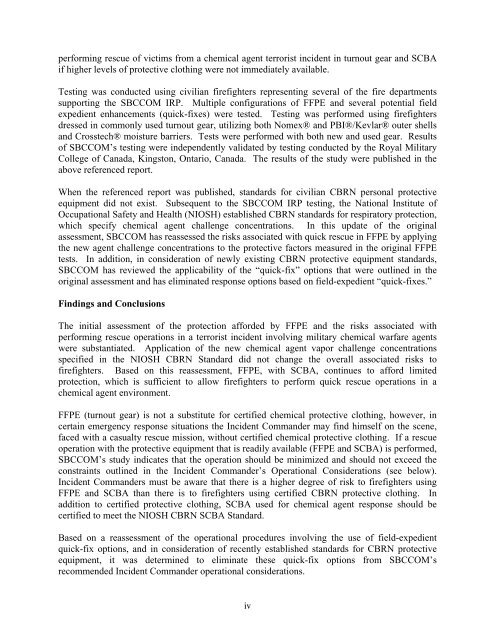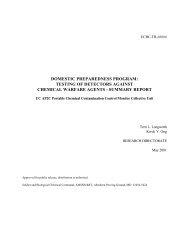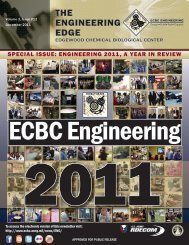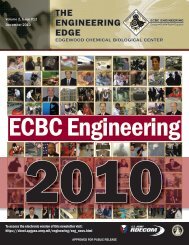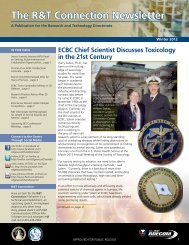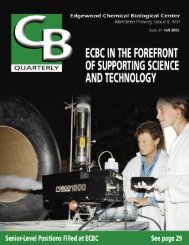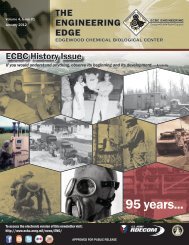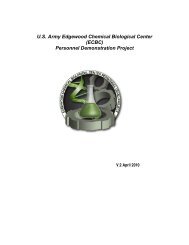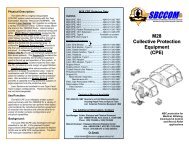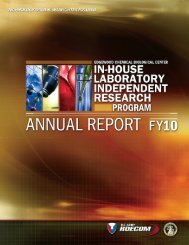(FFPE) with Self-Contained Breathing Apparatus (SCBA) for Rescue
(FFPE) with Self-Contained Breathing Apparatus (SCBA) for Rescue
(FFPE) with Self-Contained Breathing Apparatus (SCBA) for Rescue
Create successful ePaper yourself
Turn your PDF publications into a flip-book with our unique Google optimized e-Paper software.
per<strong>for</strong>ming rescue of victims from a chemical agent terrorist incident in turnout gear and <strong>SCBA</strong><br />
if higher levels of protective clothing were not immediately available.<br />
Testing was conducted using civilian firefighters representing several of the fire departments<br />
supporting the SBCCOM IRP. Multiple configurations of <strong>FFPE</strong> and several potential field<br />
expedient enhancements (quick-fixes) were tested. Testing was per<strong>for</strong>med using firefighters<br />
dressed in commonly used turnout gear, utilizing both Nomex® and PBI®/Kevlar® outer shells<br />
and Crosstech® moisture barriers. Tests were per<strong>for</strong>med <strong>with</strong> both new and used gear. Results<br />
of SBCCOM’s testing were independently validated by testing conducted by the Royal Military<br />
College of Canada, Kingston, Ontario, Canada. The results of the study were published in the<br />
above referenced report.<br />
When the referenced report was published, standards <strong>for</strong> civilian CBRN personal protective<br />
equipment did not exist. Subsequent to the SBCCOM IRP testing, the National Institute of<br />
Occupational Safety and Health (NIOSH) established CBRN standards <strong>for</strong> respiratory protection,<br />
which specify chemical agent challenge concentrations. In this update of the original<br />
assessment, SBCCOM has reassessed the risks associated <strong>with</strong> quick rescue in <strong>FFPE</strong> by applying<br />
the new agent challenge concentrations to the protective factors measured in the original <strong>FFPE</strong><br />
tests. In addition, in consideration of newly existing CBRN protective equipment standards,<br />
SBCCOM has reviewed the applicability of the “quick-fix” options that were outlined in the<br />
original assessment and has eliminated response options based on field-expedient “quick-fixes.”<br />
Findings and Conclusions<br />
The initial assessment of the protection af<strong>for</strong>ded by <strong>FFPE</strong> and the risks associated <strong>with</strong><br />
per<strong>for</strong>ming rescue operations in a terrorist incident involving military chemical warfare agents<br />
were substantiated. Application of the new chemical agent vapor challenge concentrations<br />
specified in the NIOSH CBRN Standard did not change the overall associated risks to<br />
firefighters. Based on this reassessment, <strong>FFPE</strong>, <strong>with</strong> <strong>SCBA</strong>, continues to af<strong>for</strong>d limited<br />
protection, which is sufficient to allow firefighters to per<strong>for</strong>m quick rescue operations in a<br />
chemical agent environment.<br />
<strong>FFPE</strong> (turnout gear) is not a substitute <strong>for</strong> certified chemical protective clothing, however, in<br />
certain emergency response situations the Incident Commander may find himself on the scene,<br />
faced <strong>with</strong> a casualty rescue mission, <strong>with</strong>out certified chemical protective clothing. If a rescue<br />
operation <strong>with</strong> the protective equipment that is readily available (<strong>FFPE</strong> and <strong>SCBA</strong>) is per<strong>for</strong>med,<br />
SBCCOM’s study indicates that the operation should be minimized and should not exceed the<br />
constraints outlined in the Incident Commander’s Operational Considerations (see below).<br />
Incident Commanders must be aware that there is a higher degree of risk to firefighters using<br />
<strong>FFPE</strong> and <strong>SCBA</strong> than there is to firefighters using certified CBRN protective clothing. In<br />
addition to certified protective clothing, <strong>SCBA</strong> used <strong>for</strong> chemical agent response should be<br />
certified to meet the NIOSH CBRN <strong>SCBA</strong> Standard.<br />
Based on a reassessment of the operational procedures involving the use of field-expedient<br />
quick-fix options, and in consideration of recently established standards <strong>for</strong> CBRN protective<br />
equipment, it was determined to eliminate these quick-fix options from SBCCOM’s<br />
recommended Incident Commander operational considerations.<br />
iv


